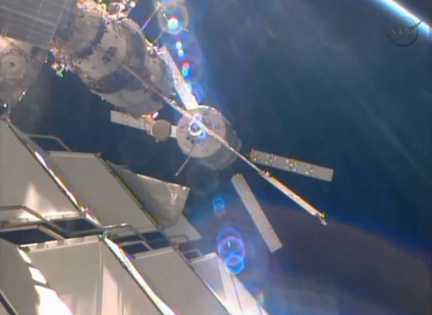European cargo ship docks with space station
06/15/2013 10:40 AM Filed in: Space News | International Space Station
By WILLIAM HARWOOD
CBS News
An unmanned European Space Agency cargo ship loaded with 7.3 tons of supplies, spare parts and science gear completed an autonomous rendezvous with the International Space Station early Saturday, gliding to a smooth docking at Russia's Zvezda command module.
Launched June 5 atop a European Ariane 5 booster, ESA's fourth and next-to-last Automated Transfer Vehicle, dubbed Albert Einstein, gently engaged the docking mechanism on Zvezda's aft port at 10:07 a.m. EDT (GMT-4) to complete a complex rendezvous sequence 250 miles above the Pacific Ocean.
"Contact confirmed," someone said in Russian. A few moments later, one of the crew members observed that docking "was softer than with the (Russian) Progress."
Tipping the scales at 44,610 pounds, Automated Transfer Vehicle No. 4 is the heaviest payload ever launched by the European Space Agency and a welcome addition for the station's six-man crew.
The spacecraft is loaded with more than 14,000 pounds of cargo, including 7,584 pounds of propellant, 1,257 pounds of water, 220 pounds of oxygen and 5,465 pounds of dry cargo, including experiment hardware, spare parts, food and clothing.
One question mark going into the final stages of the approach to the space station was the status of a laser retro-reflector mounted near the Zvezda docking port that was needed to help the ATV's navigation system compute velocity and orientation.
A jammed navigation antenna on a Russian Progress cargo ship that arrived April 26 came in close proximity to the retro-reflector, raising a bit of concern about possible damage or contamination that might prevent the ATV's navigation system from working properly.
Russian engineers said they were confident the retro-reflector was undamaged and when the Progress undocked last Tuesday, clearing the way for ATV-4's arrival, no obvious signs of damage could be seen in television views from the departing spacecraft.
But the issue wasn't fully resolved until early today when the ATV's navigation system began incorporating retro-reflector data into its computations at a distance of around 820 feet from the station.
The system appeared to operate normally, but ESA flight controllers decided to spend a bit of additional time at the so-called S3 hold point to make sure the system was healthy and to update navigation routines that would be called into play if an abort was required.
But there were no problems, and the cargo ship proceeded to a picture-perfect linkup.
CBS News
An unmanned European Space Agency cargo ship loaded with 7.3 tons of supplies, spare parts and science gear completed an autonomous rendezvous with the International Space Station early Saturday, gliding to a smooth docking at Russia's Zvezda command module.
 |
| A European Space Agency cargo ship closes in on the International Space Station Saturday, bringing 7.3 tons of supplies and equipment to the outpost. (Credit: NASA-TV) |
"Contact confirmed," someone said in Russian. A few moments later, one of the crew members observed that docking "was softer than with the (Russian) Progress."
Tipping the scales at 44,610 pounds, Automated Transfer Vehicle No. 4 is the heaviest payload ever launched by the European Space Agency and a welcome addition for the station's six-man crew.
The spacecraft is loaded with more than 14,000 pounds of cargo, including 7,584 pounds of propellant, 1,257 pounds of water, 220 pounds of oxygen and 5,465 pounds of dry cargo, including experiment hardware, spare parts, food and clothing.
One question mark going into the final stages of the approach to the space station was the status of a laser retro-reflector mounted near the Zvezda docking port that was needed to help the ATV's navigation system compute velocity and orientation.
A jammed navigation antenna on a Russian Progress cargo ship that arrived April 26 came in close proximity to the retro-reflector, raising a bit of concern about possible damage or contamination that might prevent the ATV's navigation system from working properly.
Russian engineers said they were confident the retro-reflector was undamaged and when the Progress undocked last Tuesday, clearing the way for ATV-4's arrival, no obvious signs of damage could be seen in television views from the departing spacecraft.
But the issue wasn't fully resolved until early today when the ATV's navigation system began incorporating retro-reflector data into its computations at a distance of around 820 feet from the station.
The system appeared to operate normally, but ESA flight controllers decided to spend a bit of additional time at the so-called S3 hold point to make sure the system was healthy and to update navigation routines that would be called into play if an abort was required.
But there were no problems, and the cargo ship proceeded to a picture-perfect linkup.